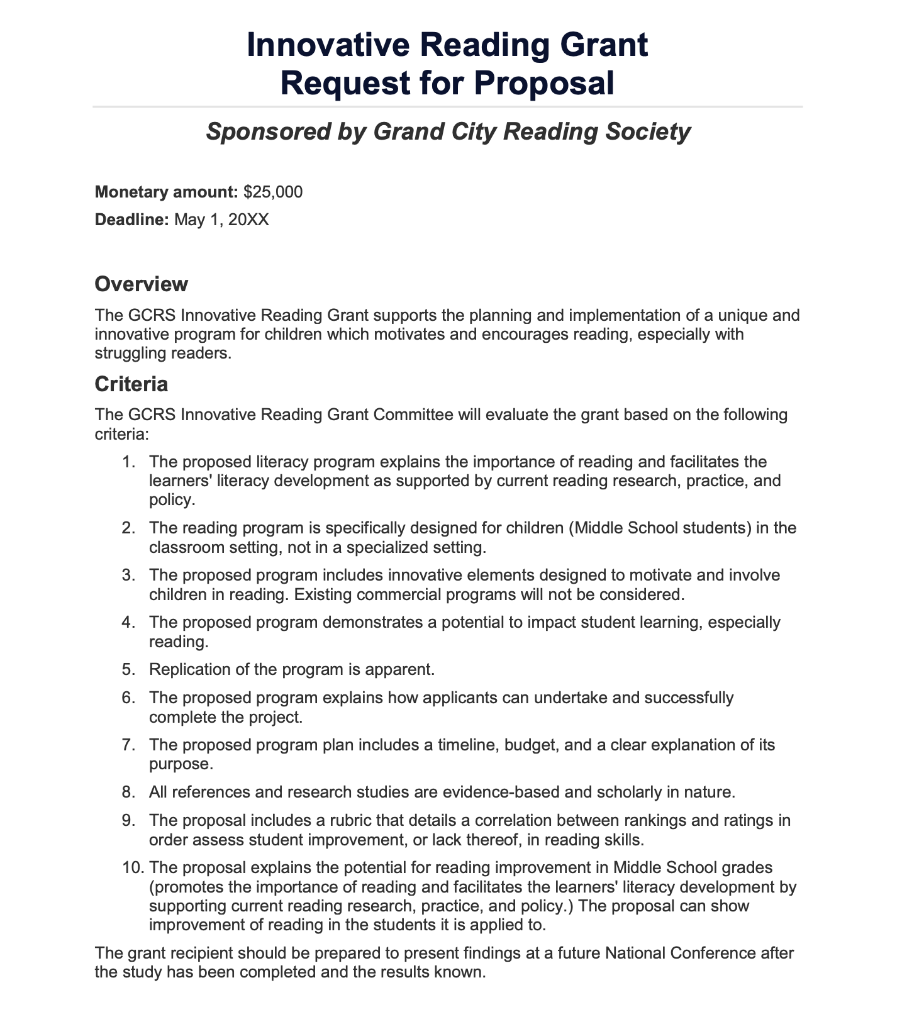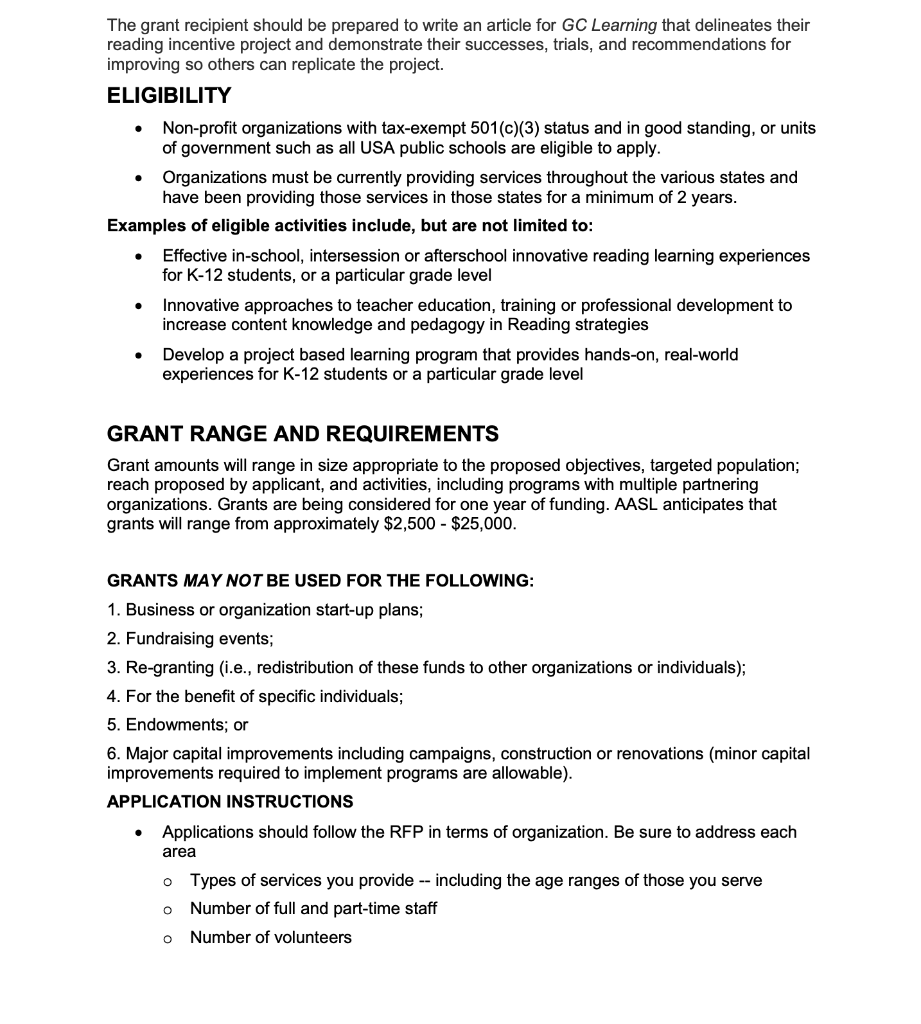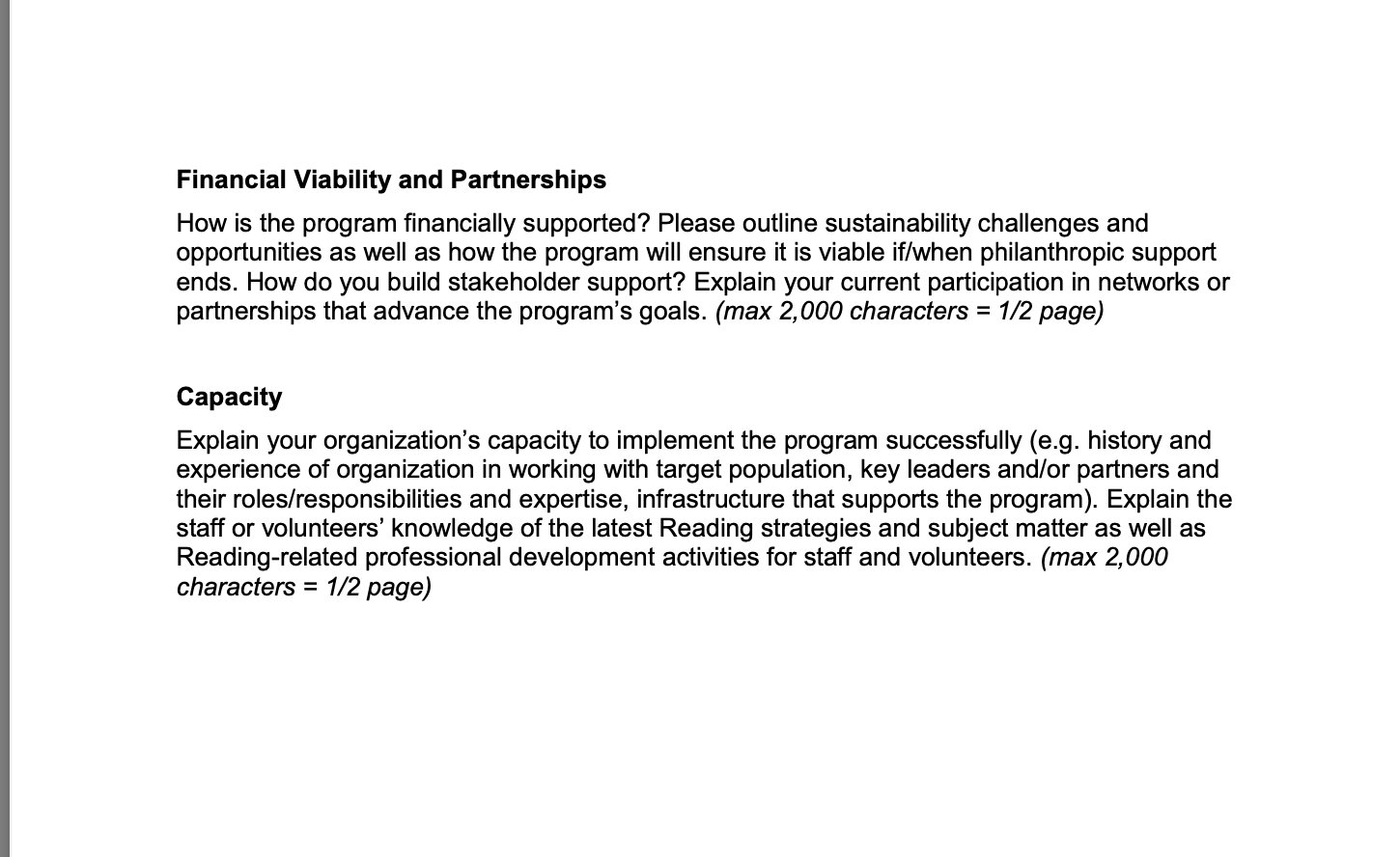- Describe the reading needs at Chester Middle School.
- Describe the amounts of funds available through this RFP and its timelines.
- Explain how the funds would be used.
- Request the superintendents approval to move forward to write the grant requesting the funds.




Innovative Reading Grant Request for Proposal Sponsored by Grand City Reading Society Monetary amount: $25,000 Deadline: May 1, 20XX Overview The GCRS Innovative Reading Grant supports the planning and implementation of a unique and innovative program for children which motivates and encourages reading, especially with struggling readers. Criteria The GCRS Innovative Reading Grant Committee will evaluate the grant based on the following criteria: 1. The proposed literacy program explai the importance of reading and facilitates the learners' literacy development as supported by current reading research, practice, and policy. 2. The reading program is specifically designed for children (Middle School students) in the classroom setting, not in a specialized setting. 3. The proposed program includes innovative elements designed to motivate and involve children in reading. Existing commercial programs will not be considered. 4. The proposed program demonstrates a potential to impact student learning, especially reading. 5. Replication of the program is apparent. 6. The proposed program explains how applicants can undertake and successfully complete the project. 7. The proposed program plan includes a timeline, budget, and a clear explanation of its purpose. 8. All references and research studies are evidence-based and scholarly in nature. 9. The proposal includes a rubric that details a correlation between rankings and ratings in order assess student improvement, or lack thereof, in reading skills. 10. The proposal explains the potential for reading improvement in Middle School grades (promotes the importance of reading and facilitates the learners' literacy development by supporting current reading research, practice, and policy.) The proposal can show improvement of reading in the students it is applied to. The grant recipient should be prepared to present findings at a future National Conference after the study has been completed and the results known. The grant recipient should be prepared to write an article for GC Learning that delineates their reading incentive project and demonstrate their successes, trials, and recommendations for improving so others can replicate the project. ELIGIBILITY Non-profit organizations with tax-exempt 501(c)(3) status and in good standing, or units of government such as all USA public schools are eligible to apply. Organizations must be currently providing services throughout the various states and have been providing those services in those states for a minimum of 2 years. Examples of eligible activities include, but are not limited to: Effective in-school, intersession or afterschool innovative reading learning experiences for K-12 students, or a particular grade level Innovative approaches to teacher education, training or professional development to increase content knowledge and pedagogy in Reading strategies Develop a project based learning program that provides hands-on, real-world experiences for K-12 students or a particular grade level . . GRANT RANGE AND REQUIREMENTS Grant amounts will range in size appropriate to the proposed objectives, targeted population; reach proposed by applicant, and activities, including programs with multiple partnering organizations. Grants are being considered for one year of funding. AASL anticipates that grants will range from approximately $2,500 - $25,000. GRANTS MAY NOT BE USED FOR THE FOLLOWING: 1. Business or organization start-up plans; 2. Fundraising events; 3. Re-granting (i.e., redistribution of these funds to other organizations or individuals); 4. For the benefit of specific individuals; 5. Endowments; or 6. Major capital improvements including campaigns, construction or renovations (minor capital improvements required to implement programs are allowable). APPLICATION INSTRUCTIONS Applications should follow the RFP in terms of organization. Be sure to address each area o Types of services you provide -- including the age ranges of those you serve Number of full and part-time staff Number of volunteers . o O REVIEW CRITERIA AND NARRATIVE QUESTIONS Proposals will be reviewed by US-based advisors and GCRS staff. The strongest proposals will be those that meet all or most of the following criteria. The following character counts are approximate to the specified page lengths based on single-spacing in Arial 12-point font with 1 inch margins. Critical Need Please explain the need or opportunity you are working to address and provide evidence that the program is addressing the need for Reading improvement in your state. Who is your targeted population, where are they located the United States and how do you reach your target audience? (max 2,000 characters = 1/2 page) Inspiration and Place-based Learning Explain how your program inspires interest and engagement in Reading. If applicable, outline how you will use these funds to promote connections between your state's cultural context and contemporary Reading strategies. How do you help participants connect Reading content to career opportunities? (max 2,000 characters = 1/2 page) Challenging and Relevant Content Detail the program curriculum. What state or national Reading standards or measures are promoted by the program? Explain how the program provides opportunities for real world applications of good Reading practices and subject matter. (max 2,000 characters = 1/2 page) Reading Practices How does the program promote active, hands-on and project-based learning activities (e.g. open ended research, asking relevant questions, designing problems, carrying out investigations, etc.)? How does the program promote skills such as innovation, creativity, critical thinking and teamwork? (max 2,000 characters = 1/2 page) Underrepresented Groups If applicable, explain how the program identifies and addresses the needs of groups underrepresented in your state or local setting. How do you promote attention to individual students' needs, diverse interests, and different learning styles? (max 2,000 characters = 1/2 page) Evaluation What results are you trying to achieve and why are they important? Please detail what data you collect to provide evidence that the program is reaching its goals and having a measurable impact on student outcomes. How often are data collected and how are data used to continuously measure and inform progress, including (if appropriate) any lessons from the data that were/are being used to revise and/or improve the program? (max 2,000 characters = 1/2 page) Financial Viability and Partnerships How is the program financially supported? Please outline sustainability challenges and opportunities as well as how the program will ensure it is viable if/when philanthropic support ends. How do you build stakeholder support? Explain your current participation in networks or partnerships that advance the program's goals. (max 2,000 characters = 1/2 page) Capacity Explain your organization's capacity to implement the program successfully (e.g. history and experience of organization in working with target population, key leaders and/or partners and their roles/responsibilities and expertise, infrastructure that supports the program). Explain the staff or volunteers' knowledge of the latest Reading strategies and subject matter as well as Reading-related professional development activities for staff and volunteers. (max 2,000 characters = 1/2 page) Innovative Reading Grant Request for Proposal Sponsored by Grand City Reading Society Monetary amount: $25,000 Deadline: May 1, 20XX Overview The GCRS Innovative Reading Grant supports the planning and implementation of a unique and innovative program for children which motivates and encourages reading, especially with struggling readers. Criteria The GCRS Innovative Reading Grant Committee will evaluate the grant based on the following criteria: 1. The proposed literacy program explai the importance of reading and facilitates the learners' literacy development as supported by current reading research, practice, and policy. 2. The reading program is specifically designed for children (Middle School students) in the classroom setting, not in a specialized setting. 3. The proposed program includes innovative elements designed to motivate and involve children in reading. Existing commercial programs will not be considered. 4. The proposed program demonstrates a potential to impact student learning, especially reading. 5. Replication of the program is apparent. 6. The proposed program explains how applicants can undertake and successfully complete the project. 7. The proposed program plan includes a timeline, budget, and a clear explanation of its purpose. 8. All references and research studies are evidence-based and scholarly in nature. 9. The proposal includes a rubric that details a correlation between rankings and ratings in order assess student improvement, or lack thereof, in reading skills. 10. The proposal explains the potential for reading improvement in Middle School grades (promotes the importance of reading and facilitates the learners' literacy development by supporting current reading research, practice, and policy.) The proposal can show improvement of reading in the students it is applied to. The grant recipient should be prepared to present findings at a future National Conference after the study has been completed and the results known. The grant recipient should be prepared to write an article for GC Learning that delineates their reading incentive project and demonstrate their successes, trials, and recommendations for improving so others can replicate the project. ELIGIBILITY Non-profit organizations with tax-exempt 501(c)(3) status and in good standing, or units of government such as all USA public schools are eligible to apply. Organizations must be currently providing services throughout the various states and have been providing those services in those states for a minimum of 2 years. Examples of eligible activities include, but are not limited to: Effective in-school, intersession or afterschool innovative reading learning experiences for K-12 students, or a particular grade level Innovative approaches to teacher education, training or professional development to increase content knowledge and pedagogy in Reading strategies Develop a project based learning program that provides hands-on, real-world experiences for K-12 students or a particular grade level . . GRANT RANGE AND REQUIREMENTS Grant amounts will range in size appropriate to the proposed objectives, targeted population; reach proposed by applicant, and activities, including programs with multiple partnering organizations. Grants are being considered for one year of funding. AASL anticipates that grants will range from approximately $2,500 - $25,000. GRANTS MAY NOT BE USED FOR THE FOLLOWING: 1. Business or organization start-up plans; 2. Fundraising events; 3. Re-granting (i.e., redistribution of these funds to other organizations or individuals); 4. For the benefit of specific individuals; 5. Endowments; or 6. Major capital improvements including campaigns, construction or renovations (minor capital improvements required to implement programs are allowable). APPLICATION INSTRUCTIONS Applications should follow the RFP in terms of organization. Be sure to address each area o Types of services you provide -- including the age ranges of those you serve Number of full and part-time staff Number of volunteers . o O REVIEW CRITERIA AND NARRATIVE QUESTIONS Proposals will be reviewed by US-based advisors and GCRS staff. The strongest proposals will be those that meet all or most of the following criteria. The following character counts are approximate to the specified page lengths based on single-spacing in Arial 12-point font with 1 inch margins. Critical Need Please explain the need or opportunity you are working to address and provide evidence that the program is addressing the need for Reading improvement in your state. Who is your targeted population, where are they located the United States and how do you reach your target audience? (max 2,000 characters = 1/2 page) Inspiration and Place-based Learning Explain how your program inspires interest and engagement in Reading. If applicable, outline how you will use these funds to promote connections between your state's cultural context and contemporary Reading strategies. How do you help participants connect Reading content to career opportunities? (max 2,000 characters = 1/2 page) Challenging and Relevant Content Detail the program curriculum. What state or national Reading standards or measures are promoted by the program? Explain how the program provides opportunities for real world applications of good Reading practices and subject matter. (max 2,000 characters = 1/2 page) Reading Practices How does the program promote active, hands-on and project-based learning activities (e.g. open ended research, asking relevant questions, designing problems, carrying out investigations, etc.)? How does the program promote skills such as innovation, creativity, critical thinking and teamwork? (max 2,000 characters = 1/2 page) Underrepresented Groups If applicable, explain how the program identifies and addresses the needs of groups underrepresented in your state or local setting. How do you promote attention to individual students' needs, diverse interests, and different learning styles? (max 2,000 characters = 1/2 page) Evaluation What results are you trying to achieve and why are they important? Please detail what data you collect to provide evidence that the program is reaching its goals and having a measurable impact on student outcomes. How often are data collected and how are data used to continuously measure and inform progress, including (if appropriate) any lessons from the data that were/are being used to revise and/or improve the program? (max 2,000 characters = 1/2 page) Financial Viability and Partnerships How is the program financially supported? Please outline sustainability challenges and opportunities as well as how the program will ensure it is viable if/when philanthropic support ends. How do you build stakeholder support? Explain your current participation in networks or partnerships that advance the program's goals. (max 2,000 characters = 1/2 page) Capacity Explain your organization's capacity to implement the program successfully (e.g. history and experience of organization in working with target population, key leaders and/or partners and their roles/responsibilities and expertise, infrastructure that supports the program). Explain the staff or volunteers' knowledge of the latest Reading strategies and subject matter as well as Reading-related professional development activities for staff and volunteers. (max 2,000 characters = 1/2 page)










